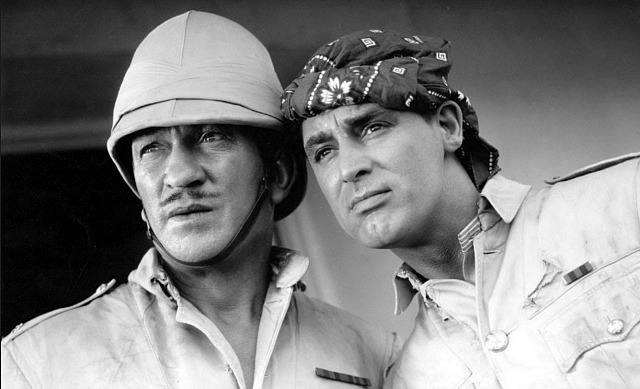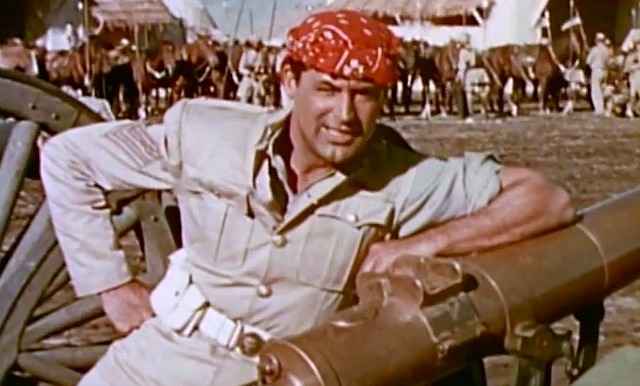The other night I streamed a handsome high-def version of George Stevens‘ Gunga Din on Amazon. I still love it for the nicely choreographed action in the first half-hour and the serious tension of the final 40 minutes (prisoners, snake pit, hostage, Sam Jaffe‘s “stupid courage,” triumphant defeat of Thug army, Kipling’s poem, Jaffe resurrected in a corporal’s uniform). That leaves 47 minutes of material that isn’t exactly tiresome or “bad” but which taxes your patience in certain ways.
I’m probably wrong in thinking that Gunga Din was the first big-budget Hollywood adventure to mix acrobatic adventure, winking humor and servings of serious drama in one package, but it was certainly one of the first. Stevens knew about laughs and slapstick choreography from having worked for comedy producer Hal Roach in the early ’30s, and he certainly used those skills here.

Victor McLaglen, Cary Grant in George Stevens’ Gunga Din.
Is there a single Millenial out there who’s even heard of this film, much less seen it beginning to end? I wonder. It doesn’t even begin to speak their language. But the afore-mentioned hour-plus (especially the opening 30) delivers so much dash and zest. You can’t help but marvel at how the individual cuts and pieces fit together just so.
In a piece called “It’s Criminal,” New Republic critic Otis Ferguson severely criticized Gunga Din for celebrating the authority of British colonialism without hesitation and at the same time depicting the “thuggee” terrorists (anti-colonialists who were more or less a late 19th Century version of India’s Viet Cong) as mere cutthroats. “So much for the content,” Ferguson concluded. He added as an afterthought that the “form” of Gunga Din is quite entertaining, rousing, thrilling, etc.
N.Y. Times critic B.R. Crisler addressed only the form in a N.Y. Times review that was published on 1.27.39:
“At its best, Gunga Din is an orchestration, taut with suspense and enriched in the fighting scenes with beautifully timed, almost. epigrammatic bits of ‘business‘ and a swinging gusto which makes of every roundhouse blow a thing of beauty. “Douglas Fairbanks leaps from roof to roof like his esteemed sire; Victor McLaglen in his uniform struts intemperately; Cary Grant clowns even beneath the lash of the cult of Thugs, even with a bayonet wound in his vitals.
“As Guru, high priest of the killer cult, whose attempted ambush of the British troops is foiled by the heroic and suicidal bugling of good old Din, Eduardo Ciannelli has stepped straight from an old-fashioned serial.
“And the hills, meanwhile, swarm with costume extras, resound with the boom of obsolete artillery, dance together in a rich confusion of tartans, turbans, and the monotonous, martial tunes of the bagpipes. Victoria Imperatrix! Involuntarily, we feel the tears start.
“Although Gunga Din is not an adult picture, when it gets going you might as well try to question the ideology of a parade of Seaforth Highlanders. Our own impulse was to run along happily beside it, dodging between the solemn grown-up legs that line the way, occasionally skipping rope.
“Another thing we like about it is the way it shoves romance (Joan Fontaine) resolutely aside when the bugles blow and the stallions begin to whinny. Who cares about all the mush stuff when there’s a good battle in prospect somewhere over beyond Cuckoo Cloudland in the Kyber Pass?”

